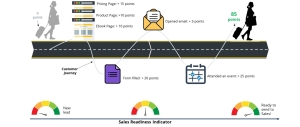Here’s an age-old point of friction between marketers and salespeople: marketers are typically evaluated on the volume of leads they generate, but often don’t receive much meaningful feedback from sales on what constitutes a “winning” lead. At the same time, sales teams can frequently be heard complaining about the quality of leads that marketing is bringing in or demand higher and higher volumes.
There are few topics that highlight the disconnect between sales and marketing more dramatically than the topic of lead generation and lead quality. Luckily, adopting a lead scoring strategy can serve as the perfect catalyst to foster alignment between these departments while ensuring the best leads make their way to sales.
But why all the fuss? Is it worth the energy to debate? Well, yes: according to Marketing Sherpa, on average 77% of organizations that adopt lead scoring experience a lift in lead generation ROI over organizations that don’t use a scoring methodology. This impressive metric indicates a sales team laser-focused on the prospective deals that really matter, working in a more cost-effective manner.
In this two-part series, we’ll explore a lead scoring strategy centered on digital behaviors that can signal readiness to buy. And we outline some helpful “pre-work” to tackle before configuring a scoring methodology that works for your organization’s sales cycle and the unique nuances of your buyer journey.
First, let’s get started with some homework. Configuring the actual scoring model is relatively easy; gaining consensus on what values to assign in the model can be the more arduous work for most organizations:
.
- Step 1: Establish a scoring committee. It’s essential to designate a representative from both the marketing and sales teams, to ensure a balanced perspective that will minimize the debate mentioned above. This group will also be responsible for reviewing your scoring model occasionally, as you may expect buyer behavior to evolve over time.
- Step 2: Compile a list of recent closed deals, including both Closed Wins and Closed Losses that have converted in the last 3-6 months. The actual volume of deals you should review will vary depending on the length of your sales cycle, seasonality impacts to your close rate, or other factors.
- Step 3: Identify the journey your winning deals pursued as they evolved from prospect a lead a opportunity a Closed Win. You’re looking for common behaviors or trends most of the Closed Wins exhibited, such as:
- Visited a specific page on your website (often sections with detailed specifications, options related to pricing, or perhaps contractual considerations)
- Registered for an event
- Completed a survey
- Downloaded a whitepaper or other digital asset
- Responded to specific emails
- Submitted a form (especially for a demo or other late-stage buyer behavior relevant for your sales cycle)
Now that you’ve identified the behaviors exhibited most frequently by Closed Wins, you’re ready to finalize your short list of lead scoring criteria. This is a great time to invoke the KISS rule on the merits of keeping things simple. While your customer journey may be a winding road across several months, there’s no need to over-engineer your model. According to a recent Gartner study (How to Maximize B2B Lead Pipeline Productivity, March 2021), companies use an average of just four different criteria when scoring leads.
We’ll walk you through configuring your scoring model and conclude with Steps 4 and 5 in our next post.
Want to learn more about lead scoring? Please contact our Sales team and stay tuned for our next article about lead scoring – Putting Together a Lead Scoring Model with ClickDimensions.









